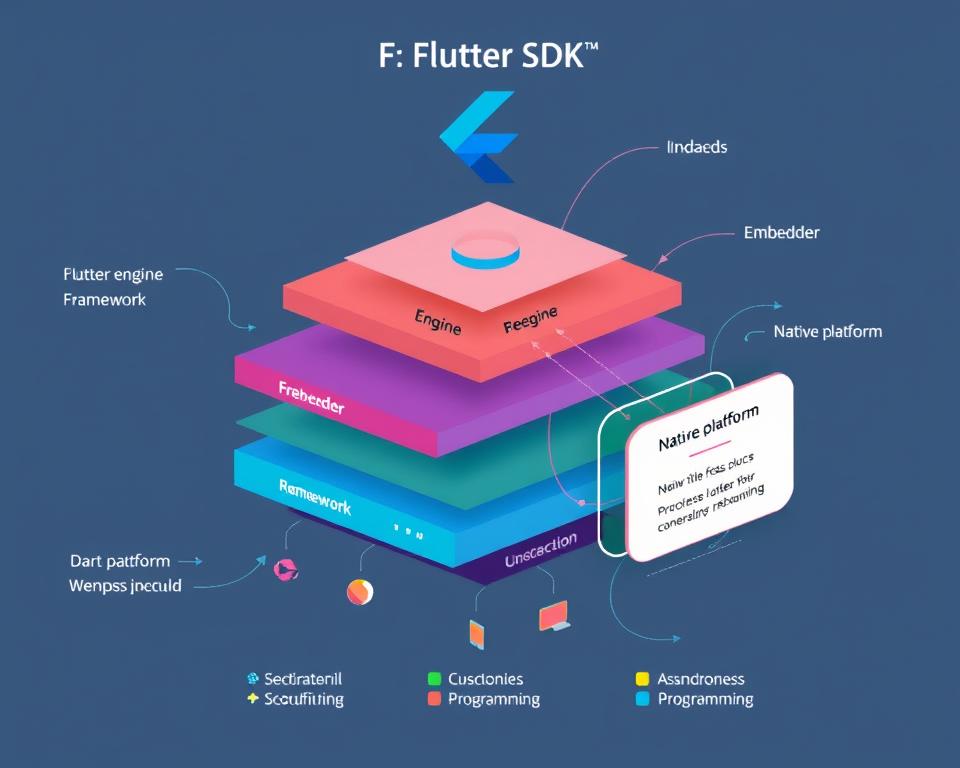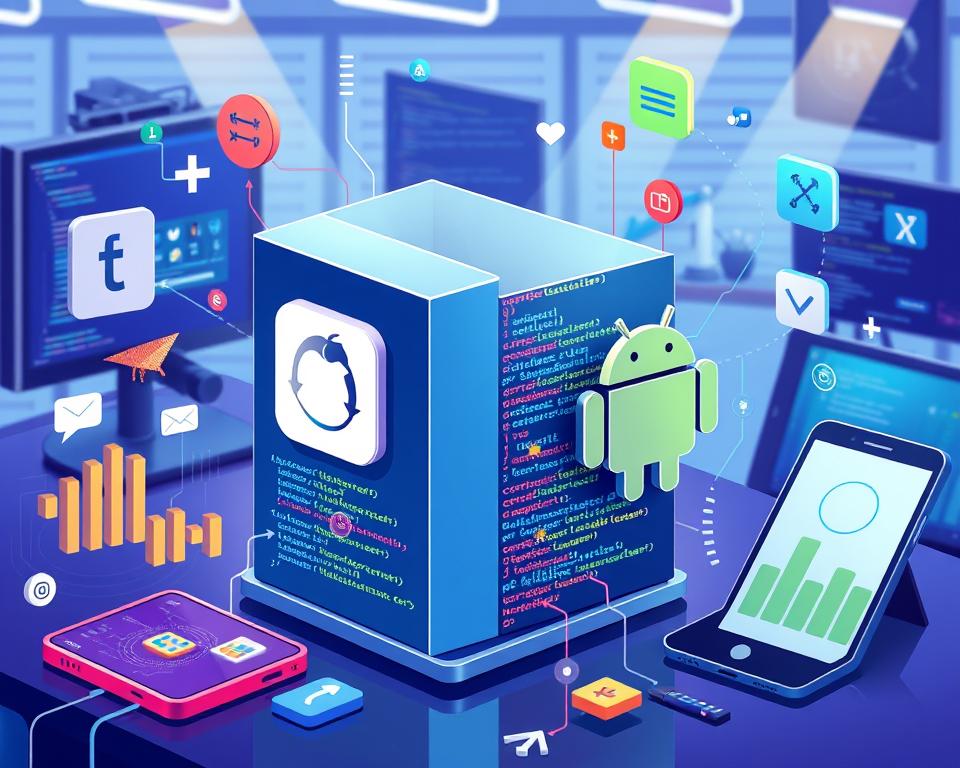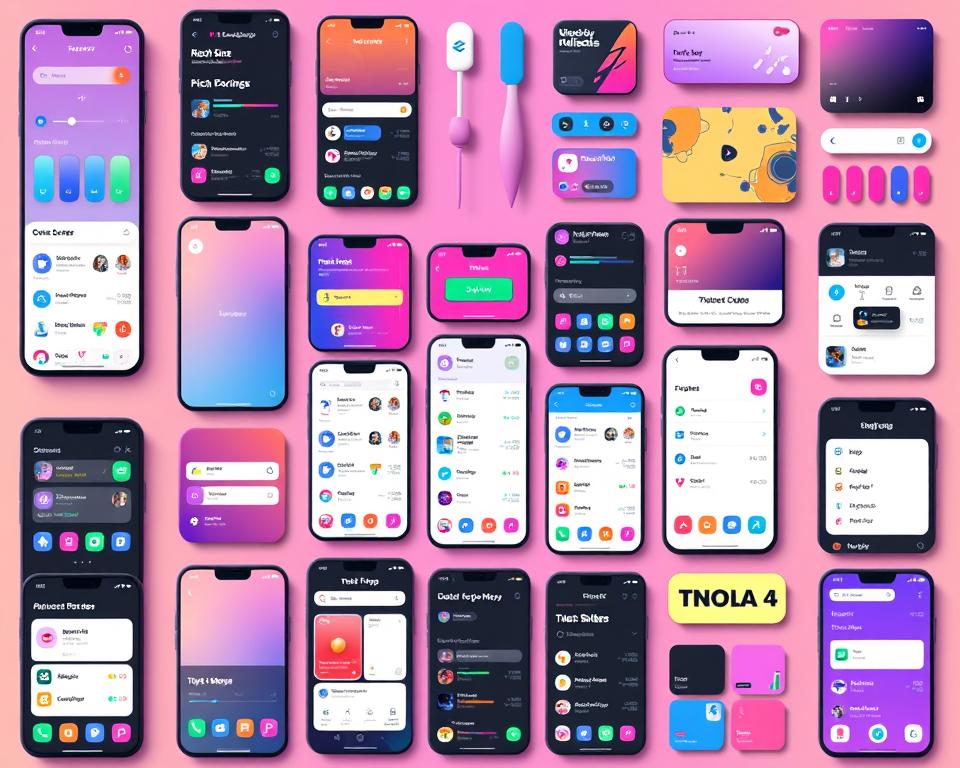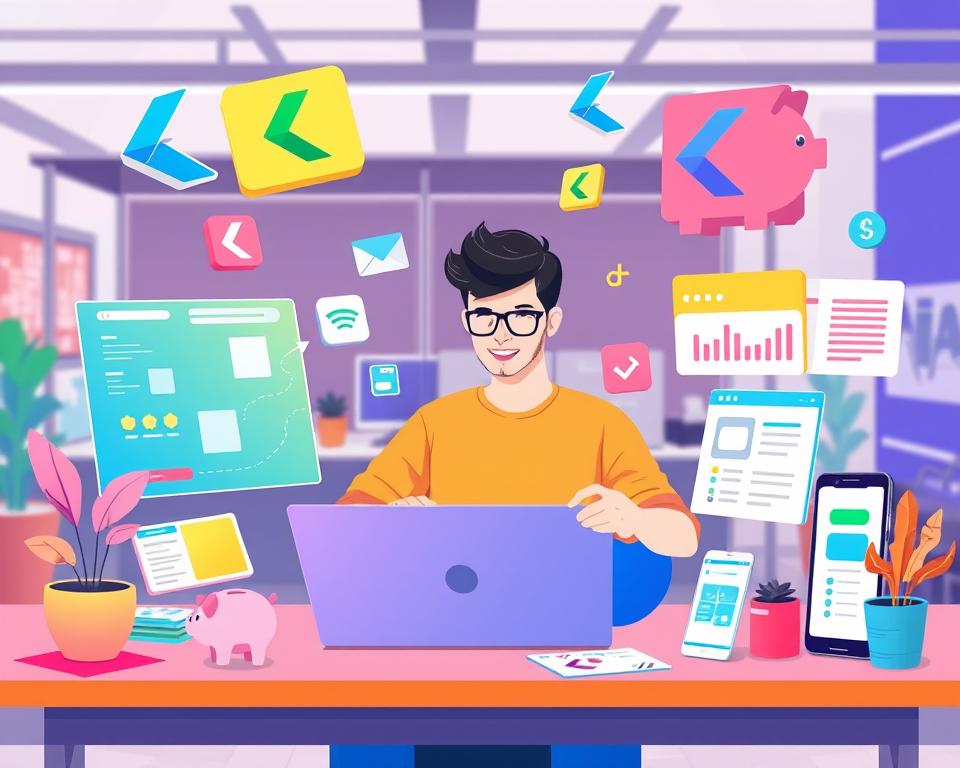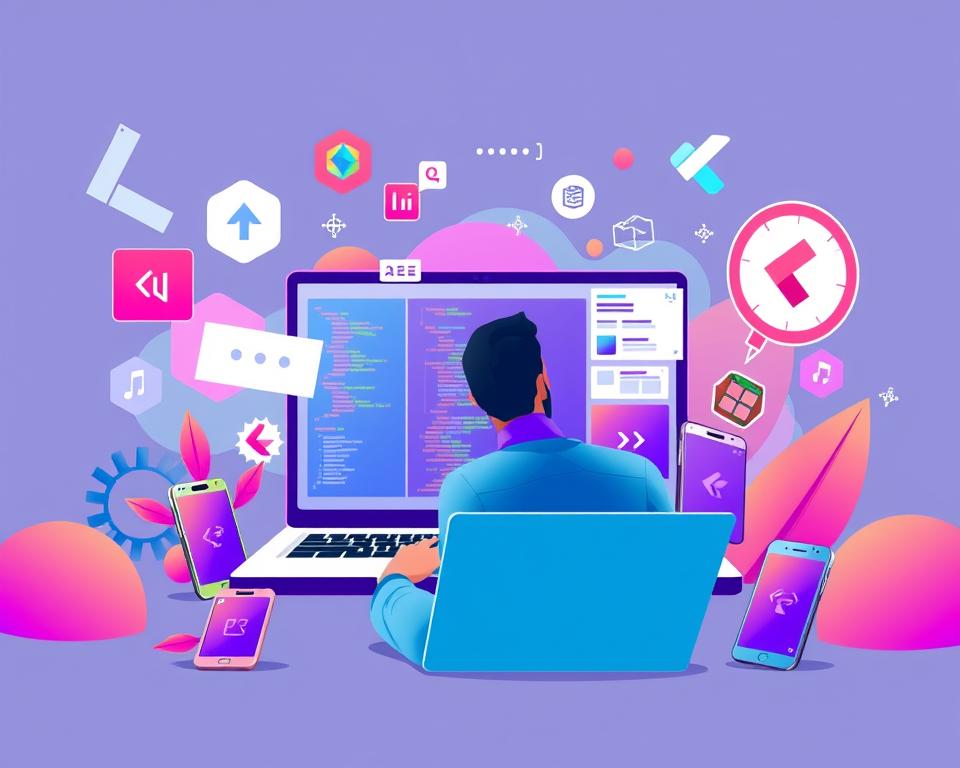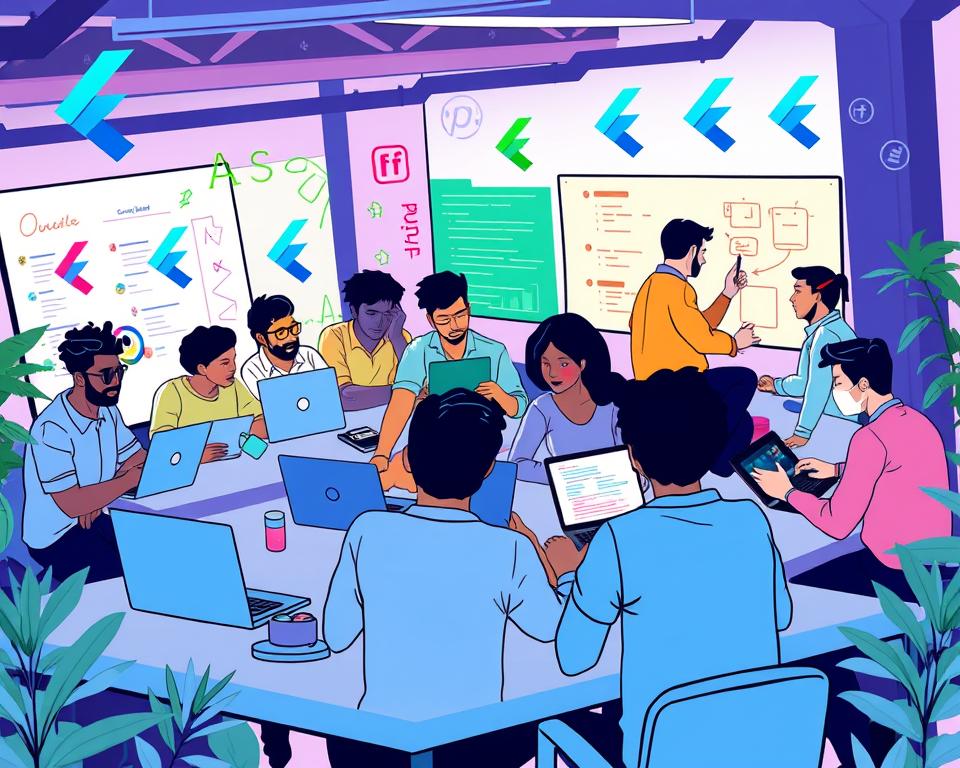In the fast-changing world of mobile app development, Google Flutter has changed the game. It’s a powerful framework that’s quickly becoming a top choice for developers. It offers a new way to tackle cross-platform projects.
Flutter was made by Google and is a full-featured solution for building apps. It lets developers make apps for both iOS and Android that look great and work well. Flutter uses the Dart language and a set of tools to help developers create apps that feel native.
Flutter stands out because it makes apps look the same on different platforms. It has a wide range of UI tools and options for customization. This means developers can make apps that look good and work well for their users.
Table of Contents
Key Takeaways
- Google Flutter is a cross-platform mobile app development framework that enables developers to build high-performance, visually stunning applications for both iOS and Android platforms.
- Flutter’s comprehensive UI toolkit and customization options allow for the creation of engaging and responsive designs that cater to the specific needs of the target audience.
- The framework’s fast development cycle, hot reload feature, and natively-compiled performance make it an attractive choice for businesses and developers alike.
- Flutter’s strong community support, extensive learning resources, and integration with Firebase and other services further enhance its appeal for mobile app development projects.
- The platform-specific design implementation capabilities and performance optimization features of Flutter ensure that developers can create tailored experiences for both iOS and Android users.
Understanding Flutter: A Cross-Platform Development Framework
The Flutter SDK is a top open-source mobile app framework by Google. It started in 2017 as an experiment. Now, it’s a strong widget-based UI for making fast, reactive framework apps for iOS and Android with one code.
The Evolution of Flutter Development
Flutter has grown a lot since it began. It went from a test project to a reliable tool for making apps for both iOS and Android. More and more developers around the world are using it.
Core Components of Flutter Architecture
The Flutter SDK has key parts that make app making easy. At its center is Dart, a programming language that’s the base of Flutter.
Dart Programming Language Fundamentals
Dart language is key to Flutter. It’s a modern, safe language with features like type safety and async/await. Knowing Dart well is important for making great Flutter apps.
| Feature | Description |
|---|---|
| Type Safety | Dart’s strong type system helps catch errors early, improving code quality and maintainability. |
| Async/Await Support | Dart’s async/await constructs simplify asynchronous programming, making it easier to work with I/O-heavy tasks. |
| Standard Library | Dart’s extensive standard library provides a wide range of built-in tools and utilities, reducing development time. |
“Flutter’s cross-platform capabilities, combined with the power of the Dart language, have made it a game-changer in the world of mobile app development.”
Single Codebase for iOS and Android Development
Building mobile apps can be hard and take a lot of time, especially for different platforms. But, Flutter has changed how we make cross-platform apps. It lets us make a unified codebase for iOS and Android.
Flutter’s power means we can write one code for both iOS and Android. This makes app development faster and cheaper. It’s a big win for making apps.
Having one codebase means we can reuse code. We write the app’s core in Dart and use it for both platforms. This saves time and effort because we don’t have to keep separate codes.
| Feature | Benefit |
|---|---|
| Unified Codebase | Enhances code reusability and reduces development time |
| Cross-Platform Compatibility | Ensures consistent user experience across iOS and Android |
| Simplified Maintenance | Streamlines the process of updating and maintaining the app |
Also, one codebase means users have the same experience on both platforms. This makes the app feel the same on any device. It’s good for the user’s experience.
Lastly, it’s easier to keep the app up to date. We don’t have to deal with different codes for each platform. This makes maintenance simpler and faster.
In short, Flutter’s single codebase is a big plus. It helps us reuse code, work on multiple platforms, and make app development easier. It’s a win-win for developers and users.
Hot Reload Feature: Accelerating Development Speed
Flutter’s “Hot Reload” feature is a big deal for making mobile apps. It lets developers see their code changes right away. This makes the app-making process much faster.
With Hot Reload, making apps is quicker. Developers can rapidly develop, instantly update, and live code their apps. This boosts how much they can do and how well they do it.
Real-time Code Changes and Preview
The Hot Reload feature in Flutter shows code changes right away. You don’t have to restart the app or lose your work. This makes it easy to keep trying new things and improving your app.
Debugging and Testing Efficiency
Flutter’s Hot Reload is great for finding and fixing problems. You can see how your code changes affect the app right away. This means you don’t have to wait for long rebuilds and restarts.
This makes your code better and gets your app to market faster.
Developer Productivity Enhancement
Hot Reload changes how developers work. It lets them focus on their main tasks without waiting for rebuilds. This means they can try new ideas and make better apps faster.
“The Hot Reload feature in Flutter has been a game-changer for our development team. It has significantly reduced our development cycle and enabled us to explore new ideas with greater agility.”
– Jane Doe, Lead Mobile Developer
Native Performance and Smooth Animations
Flutter, a cross-platform development framework, shines with its native-like performance and smooth animations. It uses the Skia rendering engine, a top-notch 2D graphics library. This engine powers Flutter.
The Skia engine handles graphics rendering, making Flutter apps run at 60 FPS on iOS and Android. This speed is key for smooth user experiences. It makes Flutter apps feel as good as native ones.
Flutter’s use of Skia and Dart programming language makes apps look great and run well. Its focus on 60 FPS animations and hardware-accelerated graphics makes it stand out. It’s a top pick for developers aiming for high-quality mobile apps.
| Feature | Description |
|---|---|
| 60 FPS Animations | Flutter’s Skia rendering engine allows for smooth, 60 FPS animations on both iOS and Android platforms. |
| Hardware-Accelerated Graphics | The Skia rendering engine leverages the device’s hardware to provide high-performance graphics rendering. |
| Efficient Dart Language | Flutter’s use of the Dart programming language, known for its speed and efficiency, further enhances the overall performance of applications. |
Flutter focuses on native performance and smooth animations. This lets developers make mobile apps that look good and work well. It gives users a better experience.
“Flutter’s focus on native performance and smooth animations is a game-changer for cross-platform development. It allows us to build mobile apps that feel just as fluid and responsive as their native counterparts.”
Rich Widget Library and Customization Options
Flutter’s UI components, called widgets, are key to its cross-platform success. It has a vast widget catalog for many UI elements. This helps developers make mobile apps that look great and are highly customizable.
Material Design Components
Flutter’s Material Design components work well with Android’s design language. They ensure a smooth and familiar user experience. With options for buttons, menus, and app bars, developers can keep their apps looking consistent on different devices.
Cupertino Widgets for iOS
For iOS apps, Flutter has Cupertino widgets. These widgets follow Apple’s Human Interface Guidelines. They help developers make apps that feel native on iPhones and iPads.
Custom Widget Development
Flutter also lets developers make their own UI components. This means they can use unique designs and special features. With Flutter’s tools, apps can look great on both iOS and Android.
| Widget Type | Description | Customization Options |
|---|---|---|
| Material Design Widgets | Optimized for Android platforms, providing a familiar and consistent user experience. | Extensive customization options for colors, shapes, and interactive behaviors. |
| Cupertino Widgets | Designed to match the native iOS user interface, ensuring a seamless experience on Apple devices. | Customization of colors, fonts, and layout to align with iOS design standards. |
| Custom Widgets | Developers can create their own unique UI components to meet specific application requirements. | Complete control over the visual appearance, behavior, and integration with the overall application design. |
Cost-Effective App Development Solutions
Cost is a big deal in mobile app development. Luckily, Flutter offers ways to save money and speed up app release. With Flutter, developers can make apps for both iOS and Android using just one codebase. This cuts down on reducing development costs and resource efficiency.
Flutter helps save money by making app development faster. Its hot reload feature lets developers see code changes right away. This makes app development quicker and more efficient. Businesses can get their apps to users faster.
| Benefit | Description |
|---|---|
| Reduced Development Costs | Flutter’s cross-platform approach allows developers to create a single codebase for both iOS and Android, significantly reducing the resources and time required to build and maintain multiple native apps. |
| Faster Time-to-Market | The hot reload feature in Flutter enables developers to instantly see the results of their code changes, accelerating the development and testing process. |
| Resource Efficiency | By using a single codebase for both platforms, Flutter minimizes the need for specialized teams and resources, leading to more efficient app development and deployment. |
Flutter also has a big widget library and customization options. This makes it easy to create beautiful and engaging apps. With Flutter, businesses can save money, get apps out faster, and use resources more efficiently. This means a better return on investment (ROI) for their mobile app projects.
The Benefits of Flutter for Mobile App Development
The Flutter framework is changing the game in mobile app development. It offers many benefits that give businesses and developers a big edge. Flutter makes apps faster to deploy and reach more people, changing how apps are made and shared.
Time-to-Market Advantages
Flutter is great because it makes app development much quicker. It uses one code for both iOS and Android, making apps better and faster. This means apps hit the market sooner, helping businesses stay ahead and grab new chances.
Resource Optimization
Flutter’s cross-platform nature helps save resources. Developers can work on one app for all platforms, saving money and time. This lets businesses focus more on making great apps and improving user experiences.
Market Reach Enhancement
Using Flutter, businesses can reach more people. They can make apps that work on both iOS and Android with just one code. This helps them get more users and grow their market share.
Flutter’s benefits for mobile app development are clear. It makes apps faster, saves resources, and reaches more people. This powerful tool is helping businesses stay ahead and create amazing user experiences.
Flutter’s Integration with Firebase and Other Services
Mobile app development is always changing. Developers look for ways to make backend integration and cloud services easier. Flutter, a cross-platform framework, has made this easier by integrating with Firebase and other services. This simplifies app development and boosts functionality.
Flutter’s big plus is its backend integration abilities. It works well with Firebase, a big app development platform. This lets developers use many cloud services like databases, authentication, and hosting. It makes building apps easier and saves time and money.
Flutter also works well with other cloud services like AWS, Google Cloud, and Microsoft Azure. This means developers can add lots of features to their apps. It makes the apps better for users.
Using these integrations, developers can focus on making apps look good and work well. The cloud services handle the backend. This makes development faster and ensures apps are reliable and secure.
“Flutter’s integration with Firebase and other cloud services has been a game-changer for our team. It has allowed us to develop feature-rich mobile applications with greater efficiency and speed.”
In short, Flutter’s integration with Firebase and other services is a big help for app developers. It makes backend integration, cloud services, and API connectivity easier. This lets developers make strong, scalable apps that give great user experiences.
Community Support and Learning Resources
The Flutter community is a vibrant place full of support and learning tools for developers. It offers official guides, tutorials, and a wide range of packages and plugins. This helps developers overcome the learning curve and use Flutter’s full potential.
Official Documentation and Tutorials
The Flutter team at Google has created detailed documentation. It’s a key resource for developers, covering Dart basics to advanced app building guides. The Flutter website also has tutorials, sample projects, and best practices. This makes it simple for developers to start with Flutter.
Third-party Packages and Plugins
Flutter’s open-source nature has led to a community of developers adding packages and plugins. These extras add features like state management and UI components to apps. Thanks to these contributions, learning Flutter is easier and faster.
For both experienced and new developers, Flutter offers strong community support and learning resources. It’s a welcoming and empowering platform for creating mobile apps.
Enterprise-Grade Security Features
Businesses now rely more on mobile apps to improve operations and customer service. They need strong data protection, secure communication, and encryption. Flutter, a cross-platform tool, provides top-notch security features for today’s mobile apps.
Flutter’s encryption capabilities are a key part of its security. It uses standard encryption like AES and RSA. This keeps data, like login details and financial info, safe from hackers.
Flutter also focuses on secure data storage. It has secure file storage and SharedPreferences API. These help developers keep sensitive data safe on devices, lowering the chance of leaks or tampering.
Flutter also works well with authentication and authorization services like Firebase Authentication and Google Sign-In. This makes it easy to add strong user authentication. It ensures only the right people can get into your app and its private areas.
| Security Feature | Description |
|---|---|
| Encryption | Leverages industry-standard encryption protocols (AES, RSA) to protect sensitive data in transit. |
| Secure Data Storage | Securely stores sensitive data on the device, preventing unauthorized access or data leaks. |
| Authentication and Authorization | Integrates with third-party services to implement robust user authentication and access control mechanisms. |
Using Flutter’s security features, developers can make apps that are both great for users and safe. This builds trust with customers and stakeholders.
Platform-Specific Design Implementation
Flutter is great for making mobile apps because it lets you design for each platform with one code. It has many tools and APIs. These help developers add features specific to iOS and Android, making apps look and feel native.
Adaptive Design Patterns
Flutter’s design patterns make user interfaces that change to fit each platform’s look and feel. It uses special widgets and layouts. This way, Flutter apps look like they were made for the device’s operating system.
- Adaptive Material Design for Android
- Cupertino (iOS-style) widgets for iOS
- Responsive layout management based on platform orientation and screen size
Platform Integration Capabilities
Flutter lets developers use native features of each platform. This makes the app feel smooth and natural. It’s about using special APIs, accessing sensors, and using UI elements and gestures specific to each platform.
- Seamless integration with iOS and Android APIs
- Access to device hardware such as camera, GPS, and sensors
- Utilization of platform-specific UI components and gestures
Flutter combines a single codebase with the power to design for each platform. It also integrates with native features. This way, developers can make mobile apps that look and feel native on many platforms.
Performance Optimization and Best Practices
To get the most out of your Flutter app, focus on performance. Learn about app optimization, memory management, and using Flutter’s profiling tools. These skills will take your app to the next level.
Efficient memory management is key for fast Flutter apps. Keep an eye on your app’s memory to avoid slowdowns. Use Flutter’s tools to find and fix memory leaks and improve your app’s performance.
Choosing the right widgets is also important. Pick and customize widgets that fit your app’s look and feel. Use profiling tools to check your app’s speed and make it smoother for users.
| Optimization Technique | Description |
|---|---|
| Memory Management | Keep an eye on your app’s memory to avoid slowdowns. |
| Widget Optimization | Choose and customize widgets that fit your app’s design. |
| Profiling Tools | Use Flutter’s tools to check your app’s speed and make it smoother. |
Follow these best practices and use Flutter’s tools to improve your app. This will make your app faster, more engaging, and competitive in the app world.
“The key to building high-performance Flutter apps lies in mastering the art of app optimization, memory management, and profiling.”
Unlocking the Power of Profiling Tools
Flutter’s profiling tools help you understand your app’s performance. Use Dart DevTools to see how your app uses memory and runs. This will help you find and fix problems.
- Use Dart DevTools to check your app’s memory and find leaks.
- See how your app runs with the performance overlay.
- Find performance issues with the timeline tool.
By using Flutter’s profiling tools, you can make your app run smoothly. This will give your app an edge in the competitive app market.
Conclusion
Flutter has changed the game in mobile app development. It offers native-like performance and fast development. It also has a wide range of customization options.
As mobile app development moves towards cross-platform solutions, Flutter is leading the way. Its strong ecosystem, community support, and integration with services like Firebase make it a top choice. Businesses can get their apps to market faster, save resources, and reach more people.
Choosing Flutter for your app is a smart move, whether you’re an experienced developer or new to mobile apps. It sets your app up for success in the fast-changing world of mobile app development. The future of cross-platform development is bright, and Flutter is right at the center of it all.








